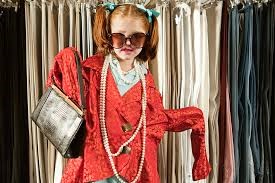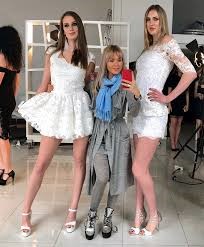Why do I (and many other women) only seem to buy clothes from the same 3-4 companies all the time? For me, it’s not so much a preference (or the fact that they’re a lot cheaper than Topshop), it’s because these are the few shops where I can actually buy clothes in MY size.
And so is the struggle of many people. “Ooh XXX have a sale- oh wait, they don’t do my size”. *goes on website…checks sizes…exits website and huffs*.
Now don’t get me wrong, it does have its perks- think of all the money I’ve saved because I can’t actually buy anything 🙂

Over the past few years, there has been an “inclusive fashion” movement among retailers whereby they have extended their clothing size range beyond the traditional 8-14s, to cater for women of “all shapes and sizes”. Shops have gone from offering 4 or 5 sizes to 9+. So what’s the problem? Well, for one, the range only seems to extend to suit one body type.
While an increasing number of retailers now offer sizes over 16, very few cater below a 6. Now, to my delight, around 2 years ago Primark began producing clothes in a size 4 – but this was at least 5 years after they began producing sizes up to a 22.
Yes, there’s a whole debate and backlash about this; some believe that offering smaller sizes promotes an unhealthy lifestyle and reinforces beauty standards, with others saying how one extreme is no better than another, and promoting larger sizes contributes to the normalisaion of obesity.
But this is not about that. Trust me, I did my A Level HE assignment on this topic and drafted and redrafted a literature review around FIFTEEN times so I am not even going into this *has flashbacks and shudders*.
I’m simply saying that yes, it’s obviously good that retailers are adapting to meet the needs of their customers, but why cater for one type over another? I just want a pair of jeans like, it shouldn’t be this hard.
It does lower your self esteem when you bring 7 items into a changing room and none fit or look nice, but that’s not just the case for larger sizes. Do you know how it feels to look like you’re wearing your mother’s clothes? Not good (no offence, ma – I think your clothes are lovely). It probably feels just as bad as looking like you accidentally tumble-dried your clothes and shrunk them.

I welcome retailers extending their size range and catering for more than 5 sizes, I don’t think anyone should have to go a certain shop/s to be able to buy their size, or settle for clothes too big or too small for them. I’m just saying that retailers need to branch out a bit more. “Start doing a size 16, that’ll keep ’em happy”- well Mr Multi-National Retailer, on behalf of said “’em”, we are not happy.
Bringing in an additional 2/3 sizes doesn’t make you ‘inclusive’. Being inclusive means bringing in a variety of new sizes. Only extending your range to suit one body type actually makes you more exclusive than inclusive, just saying.
Don’t get me wrong, “inclusive” fashion is great – as long as you’re between a size 10-14 and are no shorter than 5 ft 3 or taller than 5 ft 7.
Now, some retailers have started offering a “petite” or “tall” range, thank God. But why?
If the average woman in Ireland, the UK, America, and most countries is around 5 ft 4, why are nearly all clothes made to suit people who are over 5 ft 6? And why are the models always 5 ft 7 – 5 ft 10? Surely it doesn’t make much sense to make clothes which only fit a a very small proportion of your customer base rather than the majority? But maybe I’m just being fussy, idk.

And so is the beauty of online retailers – they offer plus size ranges, size 4s, maternity wear, petite and tall ranges *heavenly choir sings “ahhhh”*.
I personally prefer online shopping, but it’s not because I can buy clothes from the comfort of my bed while looking like a sight that is not fit for anyone except the postman to see (although I am determined to make dressing gowns a socially acceptable outerwear) Note: NOT a ‘house coat’. It’s because I can buy clothes.
People wonder why high street shopping is down year-on-year. Maybe we’ll go into your shop when your clothes don’t make us feel bad about ourselves and you actually do our size. And I’ll give you that gem of business advice for free.

I was planning to write about the exclusivity of the bra industry but I guess I underestimated just how exclusive the fashion industry was- silly me. So to the (I’m assuming) joy of any male readers that haven’t given up or fallen asleep already, you are spared. And well done you for making it this far, you must either be interested in what I have to say on this topic, or you’re really bored.
Now if you don’t mind, I’m going to do some online retail therapy, because I can. And because Boohoo have 30% off coats -sorry, bank account.
Niamh Murray is a 3rd year BSc in Communication, Advertising & Marketing student at Ulster University, currently on a placement year at The Irish News. She can be found on Facebook: Niamh Ni Mhuirí and LinkedIn: Niamh Murray.
Niamh, I don’t think it has so much to do with size. I think it’s more a question of budget, finding things which suit our life styles and body shapes. You need to come to France, plenty of small sizes over here to cater for the petite French woman.
I did read this to the end: neither out of boredom nor because I’m interested in fashion. I did so because good writing makes it a pleasure to read.
Hi Sheree, thanks for your feedback- I agree! It’s just that retailers seem to only look at the lifestyles and shapes of a certain customer profile and so many people find that they’re not really catered for! I think brands have a tendency to have a “one size fits all” approach. Maybe I will go to France- shopping AND a holiday sounds good to me!
Excellent idea!
Thank you so much Richard! It’s good to know that I’m achieving my aim of capturing the attention of different audiences who may not have a direct interest in the topic.